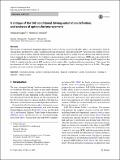| dc.contributor.author | Sheridan, Thomas B | |
| dc.date.accessioned | 2018-06-11T19:59:05Z | |
| dc.date.available | 2018-06-11T19:59:05Z | |
| dc.date.issued | 2018-02 | |
| dc.date.submitted | 2017-08 | |
| dc.identifier.issn | 1435-5558 | |
| dc.identifier.issn | 1435-5566 | |
| dc.identifier.uri | http://hdl.handle.net/1721.1/116231 | |
| dc.description.abstract | The Society of Automotive Engineers defines five levels of driving automation (LoDA) (plus a “no-automation” level 0). Among them, the third level, called “conditional driving automation,” here denoted LoDA 3, performs the complete dynamic driving task (DDT) within a limited operational domain. Although the driver is free from any driving task while the automation is engaged, she is expected to be receptive to an automation-issued request to intervene (RTI) and is also expected to perform DDT fallback in a timely manner. This paper gives a method to derive an optimal design for RTI and proves that LoDA 3 coupled with the optimal RTI should never be simply called “conditional driving automation.” This means that the definition of LoDA 3 is not complete and that at least one important level is missing in the list for LoDAs. This paper provides two ways to resolve the problem. Keywords: Automated driving; Levels of driving automation; Request to intervene; Levels of automation; Trading of authority; Shared control | en_US |
| dc.publisher | Springer London | en_US |
| dc.relation.isversionof | http://dx.doi.org/10.1007/s10111-018-0471-5 | en_US |
| dc.rights | Creative Commons Attribution | en_US |
| dc.rights.uri | http://creativecommons.org/licenses/by/4.0/ | en_US |
| dc.source | Springer London | en_US |
| dc.title | A critique of the SAE conditional driving automation definition, and analyses of options for improvement | en_US |
| dc.type | Article | en_US |
| dc.identifier.citation | Inagaki, Toshiyuki and Thomas B. Sheridan. “A Critique of the SAE Conditional Driving Automation Definition, and Analyses of Options for Improvement.” Cognition, Technology & Work (February 2018): 1-10 © 2018 The Author(s) | en_US |
| dc.contributor.department | Massachusetts Institute of Technology. Department of Aeronautics and Astronautics | en_US |
| dc.contributor.department | Massachusetts Institute of Technology. Department of Mechanical Engineering | en_US |
| dc.contributor.mitauthor | Sheridan, Thomas B | |
| dc.relation.journal | Cognition, Technology & Work | en_US |
| dc.eprint.version | Final published version | en_US |
| dc.type.uri | http://purl.org/eprint/type/JournalArticle | en_US |
| eprint.status | http://purl.org/eprint/status/PeerReviewed | en_US |
| dc.date.updated | 2018-02-27T05:14:43Z | |
| dc.language.rfc3066 | en | |
| dc.rights.holder | The Author(s) | |
| dspace.orderedauthors | Inagaki, Toshiyuki; Sheridan, Thomas B. | en_US |
| dspace.embargo.terms | N | en_US |
| dc.identifier.orcid | https://orcid.org/0000-0001-9922-3711 | |
| mit.license | PUBLISHER_CC | en_US |
